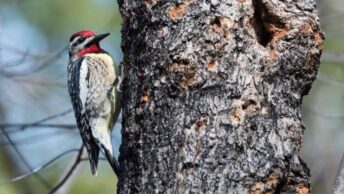Maine is the only state in the eastern United States where puffins nest. Each year from late April through August, thousands of puffins return from the open North Atlantic to breed on a handful of remote islands – Eastern Egg Rock, Seal Island, Matinicus Rock, Petit Manan Island, and Machias Seal Island. These rocky sanctuaries, many restored through Project Puffin, offer one of the best opportunities in the world to see puffins in the wild.
Though most visitors spot the familiar Atlantic species, the occasional tufted puffin (normally a bird of Alaska and the Pacific) has also appeared in recent years, hinting at subtle shifts in the ocean world that connects both coasts.
Atlantic Puffin
Fratercula arctica
- Identification: Medium-sized seabird with black upperparts, white underparts, pale face, large triangular multi-colored bill, and bright orange legs.
- Where found: Breeds on five offshore islands in the Gulf of Maine – Eastern Egg Rock, Seal Island, Matinicus Rock, Petit Manan Island, and Machias Seal Island – the only nesting sites for the species in the United States. Present along the coast from late April through August; winters far offshore in the North Atlantic.
- How to spot: Look for its football-shaped body, rapid wingbeats, and bright bill and legs in summer. Puffins are best seen rafting in groups near breeding islands or flying low over the waves from May to August, especially June and July.
- Conservation status: Vulnerable (IUCN); in Maine, populations have rebounded from near extirpation through decades of conservation and are now stable and slowly increasing.
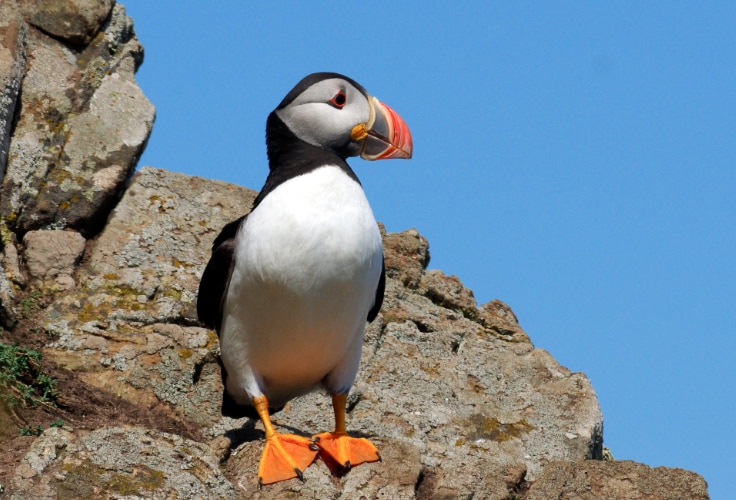
The Atlantic puffin is Maine’s signature seabird and the only puffin species that breeds on the U.S. Atlantic coast. Adults measure about 26-29 centimeters (10.2-11.4 inches) long and appear compact and round-headed, with short wings and a deep, triangular bill that glows orange and yellow during the breeding season. The pale face, dark crown, and bright feet make them unmistakable against the gray sea cliffs and open water. In flight, they beat their wings rapidly and low over the surface, while at sea they dive and “fly” underwater with their wings, steering with their orange feet.
In Maine, puffins return to their island colonies by late April and remain until early or mid-August, with a few lingering into September. They breed in burrows dug into grassy slopes or in crevices among rocks, raising a single chick each season. Their colonies – Eastern Egg Rock, Seal Island, Matinicus Rock, Petit Manan Island, and Machias Seal Island, mark the southernmost limit of the species’ global range. All are protected sanctuaries managed by the U.S. Fish and Wildlife Service and National Audubon Society, forming part of the Maine Coastal Islands National Wildlife Refuge system.
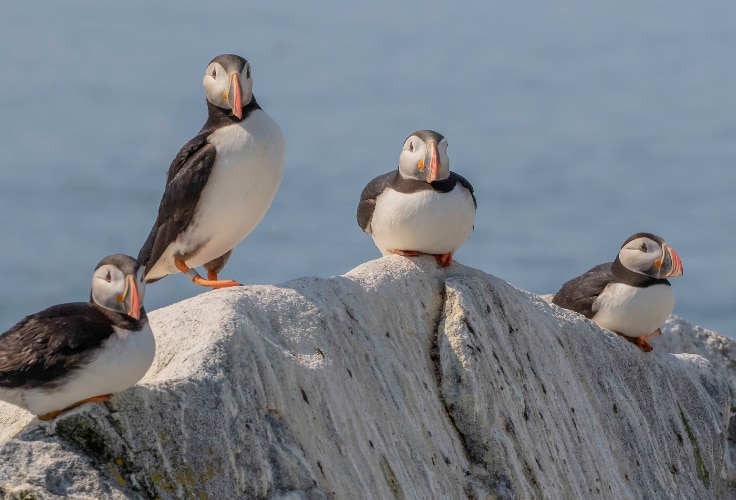
By the early 1900s, puffins had been wiped out from nearly all of Maine’s islands through hunting and egg collecting, leaving only a single pair on Matinicus Rock. Restoration began in 1973 with Project Puffin, which reintroduced chicks from Newfoundland and reduced competing gull numbers. Breeding resumed on Eastern Egg Rock in 1981 and on Seal Island in 1992, and both colonies continue to expand. Today, roughly two thousand breeding pairs nest across Maine’s five islands, with Machias Seal Island supporting the largest population and serving as the only site where visitors can view puffins from blinds.
Long-term studies show that Maine’s puffins experience high adult survival (around 97%), strongly linked to the abundance of Atlantic herring – their main prey. Breeding success is generally good, with about half to three-quarters of burrows producing fledged chicks in favorable years. Predation by large gulls and occasional shortages of small fish can reduce success locally, and the rapid warming of the Gulf of Maine remains a growing concern. Still, careful management and continuing protection of the islands have made the state’s colonies one of the world’s most successful examples of seabird restoration.
Tufted Puffin
Fratercula cirrhata
- Identification: Large puffin with an all-dark body, white face, long golden head plumes, thick orange bill, and bright orange legs.
- Where found: Native to the North Pacific. In Maine, a true vagrant – seen only a few times, most recently around offshore puffin colonies such as Petit Manan, Seal Island, Machias Seal Island, and occasionally Eastern Egg Rock.
- How to spot: Look for a larger, darker puffin among Atlantic Puffins; the golden tufts sweeping from the head and the deep orange bill are unmistakable. Sightings have occurred in summer, often near established Atlantic Puffin colonies.
- Conservation status: Least Concern (IUCN); in Maine, an exceptional rarity with only several confirmed observations, possibly linked to changing Arctic conditions that ease movement between oceans.
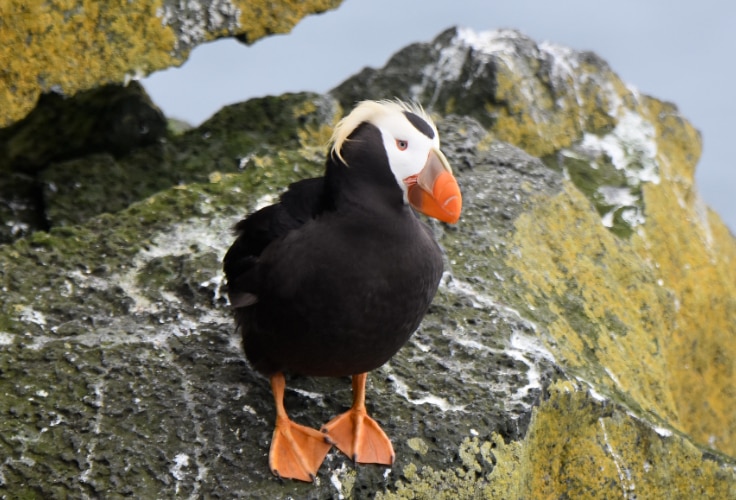
The tufted puffin is the most spectacular of the puffins, instantly recognized by its long golden plumes and massive orange bill. Native to the North Pacific, it breeds by the tens of thousands on islands from California north through the Aleutians, the Bering Sea, and into Arctic Russia. Adults measure 36-42 centimeters (14.2-16.5 inches) long, appearing heavy-bodied with a clean white face, dark plumage, and striking ornamental tufts that develop in spring.
In Maine, the species is an extraordinary visitor. The first known record dates to the winter of 1831-32, when John James Audubon obtained a specimen at the mouth of the Kennebec River – the bird he later painted for Birds of America. Since then, tufted puffins were unrecorded for nearly two centuries until modern observations in the Gulf of Maine, beginning with a well-documented sighting at Machias Seal Island in 2014 and followed by several reports since 2022. A single bird, presumably the same individual, has been observed at Petit Manan Island, Seal Island National Wildlife Refuge, Machias Seal Island, and even Eastern Egg Rock, mingling with Atlantic puffins during summer.
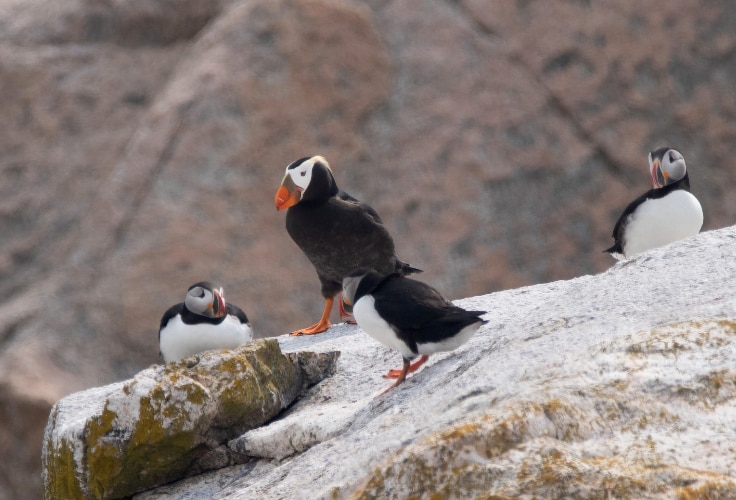
These appearances mark one of the most remarkable seabird vagrancy patterns in North America. The nearest breeding grounds lie over 4,000 kilometers (2,500 miles) away in the North Pacific. Scientists suspect that occasional tufted puffins reach the Atlantic via the melting Arctic sea routes, possibly through the Northwest Passage, which remains ice-free for longer periods in recent decades. Although this explanation remains speculative, the increasing frequency of such long-range wanderers may signal shifting ocean conditions in a rapidly warming Arctic.
For birders, encountering a tufted puffin in Maine is a once-in-a-lifetime event. The few sightings have occurred between May and August, the same period Atlantic puffins occupy Maine’s islands. Observers lucky enough to spot one usually do so from tour boats near Boothbay Harbor or Rockland, or, on rare occasions, from shore. Whether the same individual continues to return or new birds will appear remains unknown, but each sighting reminds us of how interconnected the world’s oceans and their seabirds have become.
Where to See Puffins in Maine
Maine’s offshore islands host the only nesting puffins in the eastern United States, and almost all are accessible only by boat. While the birds spend most of the year far out at sea, they return to their colonies between late April and early August, with June and July offering the most reliable viewing. During this brief window, specialized wildlife cruises and a few local ferries provide rare opportunities to see puffins up close, often alongside other seabirds, seals, and porpoises.
Eastern Egg Rock
Just six miles from New Harbor and Boothbay Harbor, Eastern Egg Rock is the southernmost puffin colony in the world and the flagship restoration site of Project Puffin. The island itself is closed to visitors, but puffins can be seen easily from tour boats. Regular departures include the Hardy Boat Cruises from New Harbor and Cap’n Fish’s Audubon Puffin Cruise from Boothbay Harbor, both narrated by Audubon naturalists who helped restore the species here. Puffins are usually seen rafting near the island or perched among terns and guillemots.
Seal Island National Wildlife Refuge
Located 21 miles off Rockland, Seal Island supports one of Maine’s largest puffin colonies and a thriving population of Great Cormorants. Tours depart primarily from Stonington and Swan’s Island, often coinciding with the Wings, Waves & Woods Festival in late May. The Isle au Haut Ferry and small charters such as Swan’s Island Charters run seasonal wildlife trips that often encounter puffins, razorbills, and terns en route. The island itself is closed to landings but offers spectacular viewing from boats.
Matinicus Rock
This remote lighthouse island lies 23 miles southeast of Rockland and is famous for its long history of puffin conservation. It was the last natural refuge for puffins in Maine after 1900. Today it’s home to hundreds of puffins, razorbills, and occasionally Manx shearwaters. Landings are not allowed, but distant viewing is possible on fine-weather days via private charters such as Matinicus Excursions out of Rockland.
Petit Manan Island
Part of the Maine Coastal Islands National Wildlife Refuge, Petit Manan lies off the Downeast coast near Milbridge and Steuben. The island supports nesting puffins, terns, Razorbills, and one of Maine’s tallest lighthouses. Puffins can be viewed on Bar Harbor Whale Watch Company trips, Acadian Boat Tours, Robertson Sea Tours, and Acadia Puffin Cruise, all operating between mid-May and mid-August. It was also the site of the 2022 tufted puffin sighting – a reminder that rare wanderers do appear.
Machias Seal Island
Straddling the maritime border between the U.S. and Canada, Machias Seal Island hosts the largest puffin colony in Maine and one of the few where visitors can go ashore. Access is strictly limited: only a few dozen people per day may land under permit, escorted to observation blinds overlooking the nesting area. U.S. trips depart from Cutler with Bold Coast Charters, while Sea Watch Tours operates from Grand Manan, New Brunswick. Landings depend on calm seas and favorable winds, but even from the boat, the sight of thousands of puffins, razorbills, and murres circling the island is unforgettable.
Independent Viewing
Puffins are rarely visible from the mainland, as all colonies lie many miles offshore. On calm summer days, experienced birders sometimes spot distant puffins from high coastal lookouts such as Pemaquid Point or Schoodic Peninsula, but such sightings are exceptional. Binoculars or a spotting scope are essential, and joining a guided cruise remains by far the most dependable way to see these seabirds.
When to Go
The best viewing season extends from late May through July, peaking in mid- to late June when adults are actively feeding chicks and making frequent flights between sea and colony. By early August, most puffins have left for open ocean. Morning and evening trips often provide the most activity, with puffins flying, diving, and resting in small rafts near the islands.
A Note on Tufted Puffins
Though not part of Maine’s regular avifauna, a tufted puffin has been reported in recent years around several of these same islands, especially Petit Manan, Seal Island, and Machias Seal Island. This exceptional vagrant from the Pacific has drawn attention worldwide and serves as a reminder of how dynamic the Gulf of Maine’s ecosystem has become.

